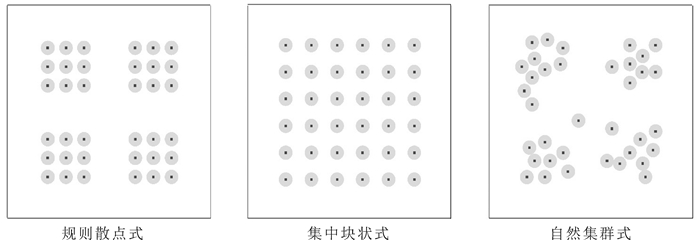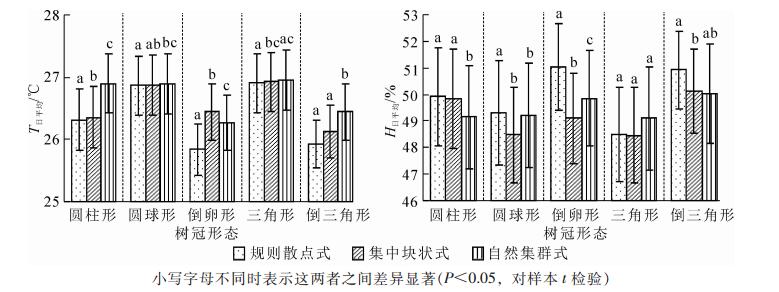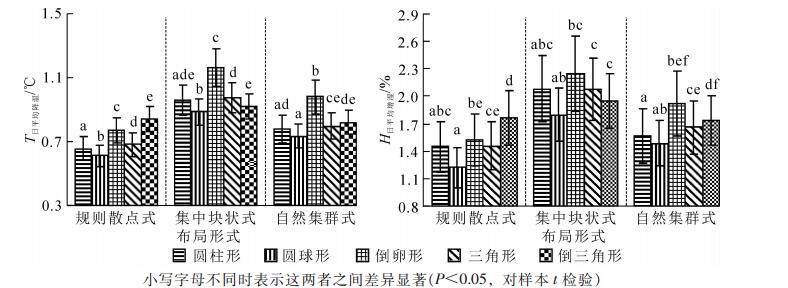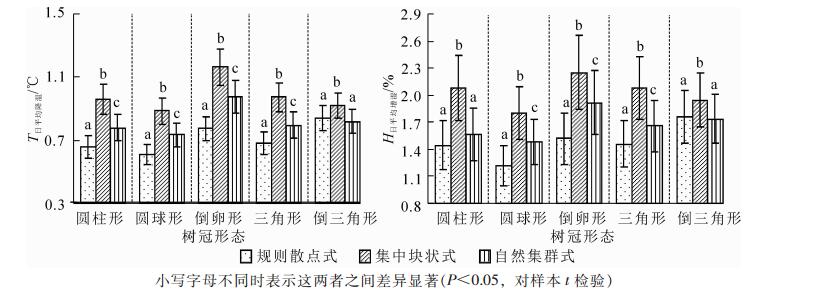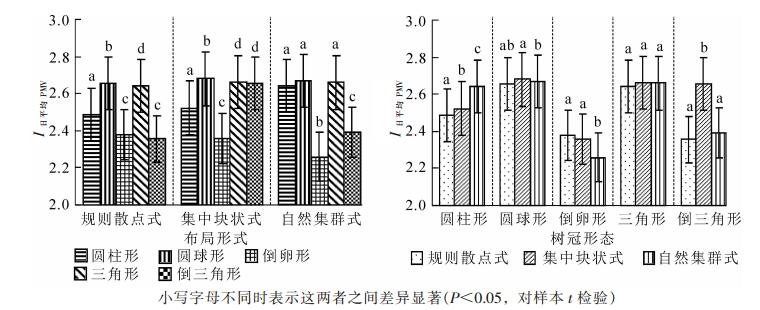-
植物群落具有显著的温湿效益,在热岛效益不断加剧的城市中发挥着重要的微气候调节作用[1-4]。植物群落的冠层结构,如郁闭度、叶面积指数、绿量、覆盖率等会影响群落的降温增湿效益[5-8],但是针对不同树冠形态和布局形式对群落微气候环境影响的研究还较为欠缺。乔木树冠反射和吸收了大量的太阳辐射,是乔木能为林下空间提供降温增湿效应的主要原因,而不同的树冠形态也会显著影响其遮阳效果[9]。关于布局形式对微气候影响的研究多集中在竖向结构上乔灌草的合理搭配[10-11],对于横向上树种的平面布局形式却较少提及。ENVI-met是一款微气候模拟软件。该软件基于热力学和流体力学原理,较为全面地考虑气候因子及其相互作用,能够动态模拟城市小尺度范围内的表面、空气和植被之间的相互作用[12]。已有较多研究从街道[13]、居住区[14]、城市中心区[15]、古典园林[16]、森林[17]等多种尺度对ENVI-met进行了校验,证实ENVI-met在模拟上的可靠性和准确性。基于上述研究基础,也有很多学者运用该软件进行纯模拟研究,如研究城市步行街空间形态对其微气候的影响[18],探讨城市空间形态指标与热环境的相关性[19],模拟分析高层住宅小区建筑形态对微气候的影响[20],以及不同绿地布局模式下居住区的夏季微气候特征[21]等。说明在条件有限且研究内容较繁杂的情况下,纯模拟的研究方式也有很高的应用价值。南京市位于长江三角洲,夏季炎热多雨,在中国夏季高温高湿气候特征的城市中具有一定代表性。为进一步探讨树冠形态和平面布局形式对夏季植物群落微气候的影响,本研究以南京市的绿地为例,运用ENVI-met软件,以纯乔木林环境为研究对象,设计多种模拟工况,分析不同树冠形态和布局形式下植物群落的温湿效应及人体热舒适度,为改善夏季微气候环境,以科学的栽植设计来适应不同类型的人群行为活动需求,提供合理的参考依据。
HTML
-
南京位于中国东部,地处长江下游,属于北亚热带中部季风气候区,四季分明,光照充足,无霜期长,热量充裕。年平均降水量为1 106.5 mm,相对湿度为76.0%,平均气温为15.4 ℃。南京是典型的夏热冬冷地区。冬季以东北风为主,1月平均最低气温为-1.6 ℃;夏季以东南风为主,7月平均最高气温为30.6 ℃。
-
由于本研究只针对树冠形态和平面布局形式对微气候的影响,但在实际情况中很难排除其他环境因素的干扰,所以实际测量的方法对本研究不具实际可行性。因此,本研究选择ENVI-met软件,使用纯模拟方法,将所有模拟工况周边环境都设置为相同条件,以保证结果的相对可靠性。
-
选取南京市理想情况下的纯乔木林群落为研究对象。通过前期预模拟,在确保温湿效果显著和便于模拟的前提下,根据常见的植物群落面积,最终确定模型大小为160 m × 160 m × 50 m,网格数为80 × 80 × 25,单个网格的分辨率为2 m × 2 m × 2 m。模型中共布局36株同种乔木来模拟纯林环境。
-
① 乔木树冠形态。乔木的树冠形态可分为规则形和不规则形,有学者[22]将常见的规则型树冠按照遮挡太阳辐射量的关系简化分成圆柱形、三角形、倒三角形、圆形和半圆形等5种基本树冠形态。通过文献资料分析,对南京地区园林中常用的100种乔木的树冠形态进行分类,确定了5种包含植物种类较多的常见树冠形态(表 1),分别为圆柱形、圆球形、倒卵形、三角形和倒三角形[23-29]。在ENVI-met中建立这5种具有典型树冠形态的乔木模型,模型剖面图如图 1所示。为保证数据可比性,所建植物模型的高度一致,均为15 m,实际栽植参考时可进行等比例缩小。圆柱形、圆球形和三角形树冠的乔木冠幅均为11 m,倒卵形树冠的乔木冠幅为13 m,倒三角形树冠的乔木冠幅为15 m。由于研究只针对树冠形态,因此将5种乔木的叶片属性、根系形态等都设置为相同指标。②平面布局形式。选择3种园林中常见的乔木群落布局形式,规则散点式、集中块状式和自然集群式(图 2)。其中规则散点式为6 × 6的点阵式排列,相邻乔木的中心点之间相距10个像素格,即20 m。集中块状式为4个3 × 3的规则散点式布局组合而成,相邻乔木的中心点之间相距6个像素格,即12 m。自然集群式中各乔木以自然界常见的集群形式分散布局。通过不同树冠形态和群落布局形式的排列组合,得出共计15种不同的模拟工况。
树冠形态 常见树种 数量/种 圆柱形 毛白杨Populus tomentosa,日本珊瑚树Viburnum odoratissimum var. awabuki,塔柏Sabina chinensis ‘Pyramidalis’,加杨(Populus × canadensis,意杨Populus × canadensis subsp. I-214 5 圆球形 白玉兰Magnolia denudata,二乔玉兰Magnolia soulangeana,乐昌含笑Michelia chapensis,深山含笑Michelia maudiae,杜仲Eucommia ulmoides,栾树Koelreuteria paniculata,樟树Cinnamomum camphora,浙江楠Phoebe chekiangensis,紫楠Phoebe sheareri,大叶樟Cinnamomum austrosinense,毛泡桐Paulownia tomentosa,重阳木Bischofia polycarpa,皂荚Gleditsia sinensis,国槐Sophora japonica,刺槐Robinia pseudoacacia,金枝槐Sophora japonica‘Golden Stem’,无患子Sapindus mukorossi,榆树Ulmus pumila,朴树Celtis sinensis,珊瑚朴Celtis julianae,榔榆Ulmus parvifolia,臭椿Ailanthus altissima,黄连木Pistacia chinensis,东京樱花Cerasus yedoensis,日本晚樱Cerasus serrulata var. lannesiana,山樱花Cerasus serrulata,女贞Ligustrum lucidum,杨梅Myrica rubra,苦槠Castanopsis sclerophylla,青冈Cyclobalanopsis glauca,麻栎Quercus acutissima,栓皮栎Quercus variabilis,苦楝Melia azedarach,香椿Toona sinensis,臭椿Ailanthus altissima,桑树Morus alba,构树Broussonetia papyrifera,美国山核桃Carya illinoensi,柿Diospyros kaki,白蜡Fraxinus chinensis,小蜡Ligustrum sinense 41 倒卵形 木莲Manglietia fordiana,乌桕Sapium sebiferum,广玉兰Magnolia grandiflora,枫香Liquidambar formosana,桂花Osmanthus fragrans,喜树Camptotheca acuminata,枫杨Pterocarya stenoptera,二球悬铃木Platanus acerifolia,银杏Ginkgo biloba,七叶树Aesculus chinensis,南京椴Tilia miqueliana,石楠Photinia serrulata,椤木石楠Photinia davidsoniae,枇杷Eriobotrya japonica,杜梨Pyrus betulifolia,山楂Crataegus pinnatifida,黄檀Dalbergia hupeana,色木槭Acer mono,茶条槭Acer ginnala,梧桐Firmiana platanifolia,梓树Catalpa ovata,楸树Catalpa bungei 22 三角形 杉木Cunninghamia lanceolata,水杉Metasequoia glyptostroboides,池杉Taxodium ascendens,柳杉Cryptomeria fortunei,落羽杉Taxodium distichum,马尾松Pinus massoniana,金钱松Pseudolarix amabilis,雪松Cedrus deodara,日本五针松Pinus parviflora,白皮松Pinus bungeana,黑松Pinus thunbergii,火炬松Pinus taeda,湿地松Pinus elliottii,油松Pinus tabuliformis,圆柏Sabina chinensis,龙柏Sabina chinensis ‘Kaizuca’,金叶桧Sabina chinensis ‘Aurea’,香榧Torreya grandis ‘Merrillii’,罗汉松Podocarpus macrophyllus,鹅掌楸Liriodendron chinense,三角枫Acer buergerianum,杜英Elaeocarpus decipiens 22 倒三角形 榉树Zelkova serrata,合欢Albizia julibrissin,垂丝海棠Malus halliana,湖北海棠Malus hupehensis,西府海棠Malus × micromalus,紫叶李Prunus cerasifera f. atropurpurea 6 垂枝形 垂柳Salix babylonica,旱柳Salix matsudana,龙爪槐Sophora japonica var. japonica f. pendula 3 棕榈形 棕榈Trachycarpus fortunei 1 总计 100 Table 1. 100 common arbors in Nanjing and the classification of their canopy shapes
-
选择的模拟日期为夏至日,为确保模拟的普适性,以中国气象数据网上公布的南京站点气象数据为参考,计算南京近10 a来夏至日的平均温湿度和风速,确定模拟当天的初始气象数据,即整个模拟环境的初始温湿度和风速数据。模拟时间从7:00到17:00,为保证模拟的准确性,去掉模拟最开始的1 h,以8:00至17:00,共计10 h作为重点分析时段,1 h输出1次模拟结果。当天每小时的温湿度值以ENVI-met的simple force模拟数据为准(表 2)。
模拟时间 气象参数 数值 土壤参数 数值 2017-06-21 10 m高度处风速 3.0 m·s-1 表层0~20 cm初始温度 300 K (7:00-18:00) 风向(0为北风,180为南风) 135 表层0~20 cm土壤湿度 50% 测量场地的粗糙长度 0.01 中层20~50 cm初始温度 300 K 大气的初始温度 297 K 中层20~50 cm土壤湿度 51% 模型顶端的绝对湿度(2 500 m) 9.5 g·kg-1 深层50 cm以下初始温度 298 K 2 m高度处的相对湿度 50% 深层50 cm以下土壤湿度 45% simple forcing—温度 最小值在5:00时,292 K 最大值在15:00时,302 K simple forcing—湿度 最小值在15:00时,40% 最大值在5:00时,60% Table 2. Setup of simulation parameters
-
从计算的模拟结果中导出各模拟工况的气温、相对湿度和PMV指数。将模拟得出的温湿度数据进行整理,首先计算出整个场地的逐时温湿度值,即80 × 80、共6 400个像素格的温湿度平均值,并利用SPSS对各工况之间的逐时温湿度进行成对样本t检验。第2步筛选出所有乔木树冠的垂直投影部分作为树荫下区域,其余为非树荫区域,分别计算出2个区域每小时的温湿度平均值,以树荫和非树荫区域的温湿度差值作为该工况乔木群落的降温增湿强度,分别用Tp和Hp表示。Tp=Tfi-Ti。其中:Tfi是第i时刻的非树荫区域的平均气温(℃),Ti为第i时刻树荫区域的平均气温(℃)。Hp=Hi-Hfi。其中:Hi为第i时刻树荫区域的平均湿度(%),Hfi是第i时刻的非树荫区域的平均湿度(%)。PMV热舒适模型是将环境变量(气温、湿度、风速和平均辐射温度)和人为因素(新陈代谢率和服装热阻)综合计算,得出用于表征人体热反应(冷热感)的评价指标,它将热感觉分为从-3(冷)到3(热)的7个等级,其中0为舒适值[30-31]。ENVI-met软件在此基础上,综合考虑了气温、平均辐射温度、水汽、风速、人体产生的能量、人体穿衣造成的皮肤温度、人体表面皮肤与空气的水汽交换、呼吸造成的能量交换等因素计算PMV指数[32]。IPMV=(0.028+0.303×e(-0.036m)+0.0275)×q。其中:m为人体新陈代谢率;q为热舒适系统的能量传输率,计算需要的变量有气温、平均辐射温度、水汽压和风速、服装热阻、人体行走产生的能量等。
1.1. 研究地概况
1.2. 研究方法
1.2.1. 建立研究模型
1.2.2. 确定模拟工况
1.2.3. 设置模拟参数
1.3. 数据分析
-
整体来看,树冠形态对群落温湿度有显著影响(图 3)。3种布局形式下都是三角形树冠的群落日均气温最高[分别为(26.91±0.95),(26.93 ±0.96),(26.95±0.97)℃],日均湿度最低(分别为48.49%±3.38%,48.46%±3.40%,49.10%±3.70%);倒卵形或倒三角形日均气温最低[分别为(25.84±0.81),(26.12±0.84),(26.27±0.89)℃],日均湿度最高(分别为51.03%±3.11%,50.13%±2.98%,50.03%±3.52%)。
-
布局形式对植物群落日均温湿度也有一定影响(图 4)。日均气温方面,圆柱形、圆球形、三角形和倒三角形树冠形态的乔木都是在自然集群式布局时日均气度最高[分别为(26.90±0.96),(26.89±0.96),(26.95±0.97),(26.44±0.91)℃],规则散点式布局时最低[分别为(26.31±0.99),(26.86±0.96),(26.91±0.95),(25.93±0.75)℃];倒卵形树冠形态的乔木在集中块状式布局时日均气温最高(26.45±0.91)℃,规则散点式时最低(25.84±0.81)℃。日均湿度方面,圆柱形、圆球形、倒卵形和倒三角形树冠形态的乔木在规则散点式布局时日均湿度最高(分别为49.91%±3.49%,49.31%±3.70%,51.03%±3.11%,50.93%±2.77%),三角形树冠的乔木在自然集群式布局时日均湿度最高(49.10%±3.70%)。圆球形、倒卵形和三角形在集中块状式布局时日均湿度最低(分别为48.47%±3.43%,49.09%±3.19%,48.46%±3.40%),圆柱形和倒三角形树冠的乔木在自然集群式布局时日均湿度最低(分别为49.15%±3.67%,50.03%±3.52%)。
-
相同布局形式下,不同树冠形态的群落降温增湿强度之间有显著性差异(P<0.05)(图 5)。总体来看,在3种布局形式下,均是倒卵形或倒三角形树冠的群落日均降温增湿强度最大[分别为(0.84±0.15)℃/(2.52%±0.54)%,(1.16±0.22)℃/(2.25%±0.78%),(0.98±0.20)℃/(1.92%±0.67%)],圆球形树冠最小[分别为(0.61±0.12)℃/(1.22%±0.42%),(0.88±0.15)℃/(1.80%±0.56)%,(0.73±0.14)℃/(1.48%±0.47%)]。
-
从图 6可以看出:布局形式对植物群落的日平均降温增湿强度具有显著的影响。总体来看,5种树冠形态都在集中块状式布局时日均降温增湿强度最大[分别为(0.96±0.18)℃/(2.08%±0.69%),(0.88±0.15)℃/(1.80%±0.56%),(1.16±0.22)℃/(2.25%±0.78%),(0.97±0.18)℃/(2.08%±0.65%),(0.92±0.15)℃/(1.95%±0.57%)]。除了倒三角形树冠的乔木群落在自然集群式布局时日均降温增湿强度最小以外[(0.82±0.14)℃/(1.74%±0.51%)],其余4种树冠形态的群落都是在规则散点式布局时日均降温增湿强度最小[分别为(0.66±0.14)℃/(1.45%±0.52%),(0.61±0.12)℃/(1.55%±0.42%),(0.77±0.15)℃/(1.52%±2.54%),(0.68±0.14)℃/(1.46%±0.49%)]。说明集中块状式布局时群落的降温增湿效应最好。
-
各模拟工况的日均PMV指数如图 7所示。3种布局形式中,均是倒卵形或倒三角树冠形态的群落PMV指数最小(分别为2.36±0.24,2.36±0.25,2.26±0.24),圆球形树冠的群落PMV指数最大(分别为2.66±0.27,2.68±0.27,2.36±0.27),说明“上大下小”型(倒三角形和倒卵形)树冠群落中,人体热舒适感觉相对较好。相同的树冠形态在不同的布局形式时,虽然PMV指数排序各有不同,但总体来看,集中块状式布局时PMV指数相对较高(最大值为2.68±0.27),而自然集群式种植时PMV指数较小(最小值为2.26±0.25)。说明自然集群式栽植时人体热舒适体验更好。
2.1. 整体区域的日均温湿度
2.1.1. 相同布局形式下不同树冠形态的植物群落日均温湿度模拟值
2.1.2. 相同树冠形态在不同布局形式下的植物群落日均温湿度模拟值
2.2. 林冠下方区域的日均降温增湿强度
2.2.1. 相同布局形式下不同树冠形态的植物群落日均降温增湿强度
2.2.2. 相同树冠形态在不同布局形式下植物群落的日均降温增湿强度
2.3. 整体区域的PMV指数
-
倒卵形和倒三角形这类“上大下小”型树冠的乔木群落对整体区域和林冠下方区域的降温增湿效果都表现最好,主要原因是“上大下小”型树冠的乔木能为林下提供更好的遮阳空间。吴翼[9]对树木遮阳效果的研究中提出,树冠形态与遮阳位置(在平面和立面上)、阵幅宽窄、遮阳面大小有直接关系,且各类树木由于其形态不同,表现差别很大;一般横展性强的树木在为行人减免日晒的作用上有显著的优越性。吴力立等[33]的研究也表明:树木在地面上影子的面积取决于树木的冠长、冠幅及太阳高度角,而与树木的高度关系不大,也就是与树木的形态有关。在高度一致的情况下,相比较其他形态的树冠,倒卵形和倒三角形树冠的冠幅更长,能为林下空间提供更好的遮阳效果。因此,在进行植物选择时,若想在夏季提供良好的降温增湿效益,可以多考虑“上大下小”型、树冠横展性强的乔木,如榉树、枫香、合欢、乌桕、七叶树等作为主要树种,而松柏类等三角形或圆球形树冠的乔木可在群落中搭配种植,提高林冠线及景观的丰富性。另外对乔木进行修剪时,也可考虑在尊重其原有树冠形态、确保植株正常生长的基础上,将植株适当修剪成“上大下小”型,进一步提高群落的降温增湿效果。
-
不同的平面布局形式对群落的降温增湿作用具有显著影响。规则散点式布局对整体区域的降温效果较好;集中块状式布局对整体区域的增湿效果及林下空间的降温增湿效益表现都比较好。因此在布局设计时,要根据实际情况合理选择植物布局形式。若要提高开阔的广场中整体区域的降温效果,缓解微尺度上城市热岛效应,可以选择规则散点排列的树阵式布局;在较为干旱的区域,可以通过集中块状布局,提高场地整体区域的湿度;如要加强林下区域的降温增湿效果,可优先选择集中块状式布局,提供大片连续的遮阴空间;若场地中有地形,不方便进行集中块状布局时,可以选择相对自然的集群式分布,更具有变化性,同时也能提供一定的增湿效果。
-
南京地区夏季高温高湿,虽然集中块状式布局时群落的降温增湿强度最高,但其PMV指数也相对最高,说明其在夏季虽然起到了很好的降温增湿效果,但在这种布局形式的群落中,人体的热舒适体验却不是很理想,反而自然集群式布局时PMV指数最低,热舒适体验更好。在树冠形态方面,倒卵形和倒三角形树冠的群落PMV值明显低于其他树冠,这与降温增湿效果的比较结果一致。所以考虑到人体热舒适度时,不能单纯以降温增湿效果作为衡量指标,尤其是在中国亚热带地区,夏季高温高湿,更应从人体舒适度角度,选择合适冠形的植物,并合理布局。
结合实际人群行为活动分别考虑,规则散点式布局时,热舒适度体验较好的区域较为分散,单个面积较小,林下适合布置小型的休憩区域,比如单人健身、棋牌类等相对分散且单个参与人数较少的活动;集中块状式布局时,热舒适度体验较好的区域较为集中,整体连接起来的面积较大且规整,适合参与人数较多的活动;自然集群式布局时,热舒适度体验较好的区域也比较集中,整体面积较大但形状自由、边界松散,林下适合布置儿童游乐、素质拓展等随机性大,鼓励自由参与的活动设施。另外,热舒适度不仅与温湿度有关,还与风速[34]、太阳辐射[35]、人群行为活动[36]以及游人心理[37]等有关,这也将是未来微气候环境设计及热舒适度研究的重点方向。本研究通过多种模拟工况比较得出乔木树冠形态和群落布局形式确实对温湿度有显著影响,虽是纯模拟研究,但部分结论也与其他学者的研究成果相契合,因此本研究对探讨如何改变群落自身结构特点来提高其微气候环境的降温增湿效益具有很好的参考价值。后续研究将与实际规划设计相结合,进一步修改周边环境因素,深入探讨群落自身结构与周边环境因子对微气候环境的双重影响。

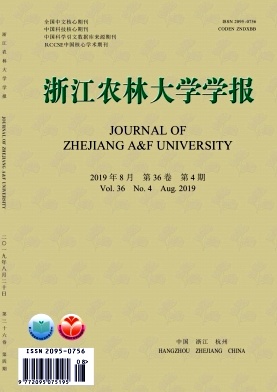


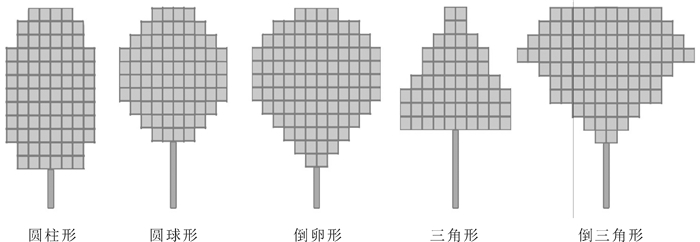









 DownLoad:
DownLoad:
